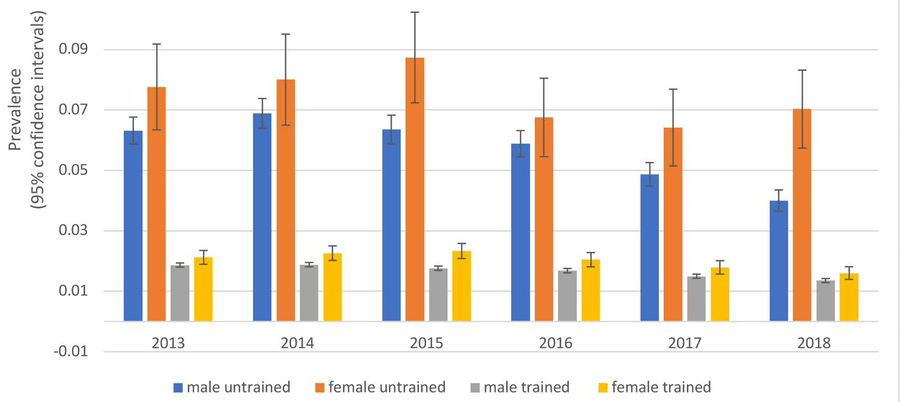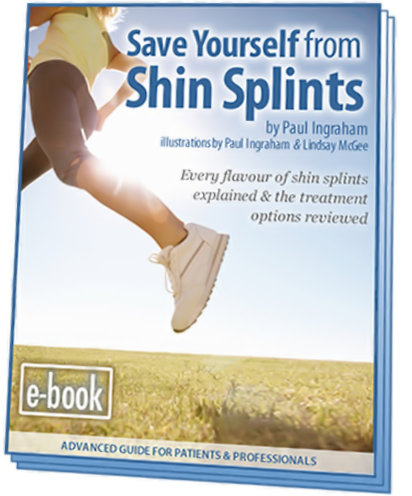Do women get more shin splints than men? New data
This post is about a big new study of the prevalence of medial tibial stress syndrome (MTSS), a major sub-type of shin splints. It’s fine data, but it can also mislead a bit in the direction (sigh) of the myth of feminine fragility. It reports MTSS in:
- 1.6% of all personnel
- 4.3% of recruits
- 7.0% of female recruits! ouch! 😮
Those stats inspired a long overdue update to my shin splints book — which got out of hand, because the new evidence weighs heavily on the tricky belief that women must be more biologically vulnerable to injury.
Women probably do get more shin splints … but probably not because they are more delicate.
The decline of book updates (but not the fall)
A bit of chatty intro before we get into the science.
The book update based on the new study was the first for the shin-book in more than three years, which is by far the most overdue update I’ve ever published. 😬
Back in the day, I made a living entirely by writing and selling e-books — I’ve written ten of them — and a big selling feature of those books was always “free updates forever.” Since 2010, half my job was just endlessly updating the books — partly to keep the promise, and partly because the subject matter really requires it.
Alas, the internet has changed, the book-selling business has been fading for years, I’ve now moved on to mostly paying the rent with a lovely little membership program, and the books truly are in need of less maintenance. And so book updates have slowed down. A lot.
I was a little horrified to notice that my shin splints book had somehow gone over three years since the last update! A gap that was once unthinkable. And so I zipped off to PubMed to look for fresh shin-pain science (because I hadn’t just stumbled on any lately)…
The “simple” shin splints science update turns un-simple
(They’re never simple, actually. But, wow, this was a really good example!)
I quickly found a a huge new prevalence study by Farquharson et al — how much shin splints in 20,000 British Armed Forces personnel? I like a nice prevalence study. It’s not the most exciting kind of science, but refreshingly uncontroversial, and they can shed a little light on the nature of the beast. I was counting on an easy new citation before moving on to something meatier.
But this prevalence study turned out to be a whole meaty meal, a bombshell for my existing chapter, “Do women really get more shin pain?” Do they have double the risk of getting shin splints? As quite strongly suggested by this data?
It’s not what it looks like! There are solid reassurances right there in the same data. Details matter, and I report on them in a way that I bet no one else has. So much for “uncontroversial”! I ended up revising the whole damn chapter. If you really want to know if women really do get way more shin splints … buy the book. 🙂 This post sticks to just reporting on the new study…
| title | Prevalence of medial tibial stress syndrome in the British Armed Forces: a population-based study |
|---|---|
| journal | BMJ Mil Health |
| Published Online First: 21 November 2024. doi: 10.1136/military-2024-002788 | |
| authors | Emma Farquharson, A J Roberts, A I Warland, N Parnis, and N E O’Connell |
| links | publisher • PubMed • PainSci bibliography |
What can you learn from 40,000 shinbones?
Farquharson et al mined data from healthcare records for over twenty thousand British Armed Forces personnel, reporting an overall prevalence of 1.6% in 2018, down from 2.2% back in 2013 — roughly 900 fewer cases across the Armed Forces.
Why did the prevalence go down? No clear reason, although they hope it’s due to “changes aiming to reduce musculoskeletal injury” such as, perhaps, “new service-issue footwear and a new system of periodised training with a greater emphasis on strength and conditioning and reduced running.” Maybe! It’s not at all surprising that “less running” and better load management would do the trick! But there’s really no interpreting the modest improvement with any confidence: “With policies and priorities differing across services and between units, it is difficult to quantify which of these changes, if any, may have had an impact.”
The prevalence was higher in recruits alone — 4.3%! Which implies that people who are straining to achieve a new level of fitness are definitely at higher risk.
And then there’s the female recruits: 7.0% of them had medial tibial stress syndrome in 2018. In contrast, male recruits alone were at 4.0% — almost half the shin pain that the female recruits had. This echoes the nasty ratio infamously reported by Yates and White way back in 2004.
Ladies are so fragile, amiright?
Noiamnot.

In that final year, on the far right … see how much bigger the male-female gap is? It was an outlier. (Click/tap to embiggen.) Image from Farquharson et al., BMJ Mil Health.
Fortunately, there are reassuring details for women
The gap between men and women was much more of a chasm in 2018 than any of the other years in the study. Women had more shin pain than men in each year, but 2018 was a particularly bad year for them, while it was the best year for the men. Exclude that year, and that female-shin-pain signal gets way weaker.
And another important point hiding in the data: what about the women who got past the difficult recruit stage? The seasoned pros, rather than the newbies? Their prevalence drops right back down to … 1.6%, exactly the same as the all-personnel average, and indistinguishable from men.
And that strongly corroborates the idea that the risk is greater for untrained people, independently of sex … but when trained, the prevalence for women drops to the same as men, or only a trivial difference.
So the shin pain risk for women is probably not a large as it seems here, and what little there is is mostly about training status — not the fragility of womanhood.
But there’s much more to say about it! About five times more … in the shin splints book.
